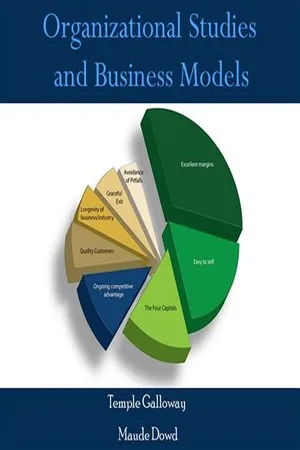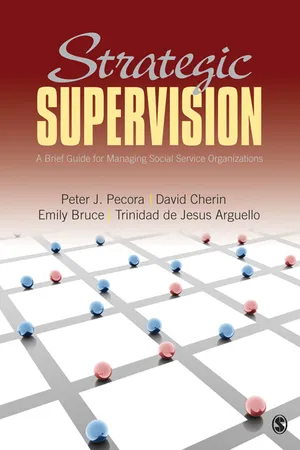Business
Functions of Organizational Culture
Organizational culture in business serves several functions, including providing a sense of identity and belonging for employees, shaping behavior and decision-making, and influencing the overall performance and success of the organization. It also helps to align employees with the company's values and goals, fostering a cohesive and productive work environment.
Written by Perlego with AI-assistance
Related key terms
1 of 5
9 Key excerpts on "Functions of Organizational Culture"
- eBook - PDF
- James L. Bowditch, Anthony F. Buono, Marcus M. Stewart(Authors)
- 2015(Publication Date)
- Wiley(Publisher)
Trice and Janice M. Beyer, The Cultures of Work Organizations, c 1993, pp. 5, 8. Reprinted by permission of Prentice Hall, Englewood Cliffs, New Jersey. powerful force in shaping behavior. Moreover, although there are multiple definitions and uses of the concept at the organizational level, an underlying, integrative theme is custom. This “normative glue” holds an organization together through traditional ways of carrying out organizational responsibilities, unique patterns of beliefs and ex- pectations that emerge over time, and the resulting shared understandings of reality at given points in time. As summarized in Table 10-1, organizational culture has several dominant char- acteristics and consequences. 3 Culture is collective in nature in that it evolves over time as people interact with each other. Through these interactions they develop and share common beliefs, values, and uncertainties, and ways of coping with them. In essence, an organization’s culture is the repository of what its members agree about. Because organizational cultures help their members manage anxieties, their substance and form are steeped with emotion, meaning, and symbolism. In contrast to organi- zational structure, culture reflects the expressive, rather than the mechanistic and pragmatic, dimension of organizational life. Given the emotive and symbolic nature of organizational culture, it is also inher- ently fuzzy in that it is not a monolithic, unitary set of ideas. As will be discussed later in this section, while researchers differentiate between “thick” and “thin” cultures, all or- ganizational cultures involve contradictions, ambiguities, and paradoxes. 4 At the same time, however, cultures can create social order from the potential chaos that permeates the open-ended nature of human behavior and interaction. Custom and continuity be- gin to emerge over time as organizational members construct and internalize “proper” attitudes and behaviors, and socialize new entrants. - eBook - PDF
- Gilbert W. Fairholm(Author)
- 1994(Publication Date)
- Praeger(Publisher)
ATTITUDES Culture also deals with attitudes, feelings, and member emotions, as well as the physical facilities of the organization. It provides and defines the emotional ambience (total surround) within which group members work. The local culture helps or inhibits what people do, why they do it, and the level of excellence attained. Culture is a part of the organi- zational ideology (the body of doctrine, myth, or symbols of a social group or movement) and, therefore, helps shape member ideas about what is right, good, and true. Culture sets the values base for the group. Values are the standards people agree on about how to measure and rate individual and group performance. Values define acceptable actions, appropriate levels of in- teractive trust, and the quality of the services or products produced. Cultural values permeate the workplace and constrain individual and team perceptions of what is proper and what is not. 76 Shaping Organizational Culture SERVICE GOALS Organizational culture in our public, private, and not-for-profit sectors share similar features. Organizational culture is based on an ideology of service coming from the values implicit and explicit in the founding doc- uments that define our nation and its institutions. Culture is also con- ditioned by agency mission and environment, but the culture is a primary determinant of group goals. It provides the standards of con- duct, defines the levels of excellence expected, and otherwise constrains and prescribes acceptable performance toward understood and mutually agreeable final products. SOCIETAL LEADERSHIP Ehrenhalt (1991) developed an interesting and evocative idea about why political leadership in America is declining. Some of his ideas also apply to business and third-sector leaders. He said America is going through a change process from leadership to openness. Ehrenhalt sees a major shift in the character, values, and purposes—the culture—of our political leadership today. - eBook - PDF
Culture 2.0
The Intersection of National and Organizational Culture
- Joann Keyton(Author)
- 2023(Publication Date)
C H A P T E R T W O Purposes, Functions, and Influences of Culture MARY M. MEARES, YULIA TOLSTIKOV-MAST, MARY SULLY DE LUQUE, HAMILTON BEAN, AND ALYSSA GIBBONS In Chapter One, the definition of culture was presented as a mutually constituted system that people use to create, share, maintain, and challenge meanings. Within this definition, national culture is associated with social/geographical groupings, with organizational culture more narrowly conceptualized as groupings of peo- ple in work environments. As Chapter One explained, the intersection between national culture and organizational culture is a natural site of study and appears across multiple disciplines. In this chapter, we will be exploring organizational culture through the perspective of five fields of disciplines (i.e., anthropology, communication, management psychology, sociology). Some of these perspectives are interrelated and others have more unique trajectories, some have an extended history and others are more recent. Psychologists tend to study culture through the lens of behavior. Early cultural studies in psychology were cross-cultural (Benet-Martinez & Oishi, 2008)—explic- itly concerned with how and why different cultural groups behaved differently. From a communication perspective, scholars examine how verbal and nonverbal communication create and confront cultural norms, as well as how employees and are shaped or guided by the norms and expectations inclusive and exclusive of the organization. The field of management was largely influenced by research con- ducted across the disciplines of sociology, anthropology, and psychology. Thus, the notion of the organization as a system of collective meaning through which commitment to, purpose in, and systems for managing and producing, emerges 20 | MARY M . MEARES ET AL . as a central theme in organization culture study. - eBook - PDF
Organizational Psychology and Organizational Behavior
Evidence-based Lessons for Creating Sustainable Organizations
- Steve M. Jex, Thomas W. Britt, Cynthia A. Thompson, Cynthia A Thompson(Authors)
- 2024(Publication Date)
- Wiley(Publisher)
Since these failures, one way NASA responded was by working with private companies, such as SpaceX, to bring in different perspectives and ideas. In addition to facilitating external adapta- tion, Schein (2010) proposed that organiza- tional culture facilitates internal integration. Consider for a moment how well an organi- zation would function if it had no identifia- ble culture. How would new members be socialized into the organization and taught how to assume their new roles? As was dis- cussed in Chapter 3, socialization is largely about learning the culture of an organiza- tion. Thus, culture is really the “glue” that bonds the social structure of an organiza- tion together. This is critical because, when all is said and done, organizations are ulti- mately social constructions and, without social integration, they would cease to exist (Katz & Kahn, 1978). However, as Schneider et al. (2017) note, and as we pointed out in the previous section on organizational cli- mate, there is little research investigating the impact of a lack of consensus on culture (or climate), so although such conclusions make sense, they are premature. Organizational Culture and Climate 652 This integrative function of culture occurs at multiple levels of an organization, and thus explains why organizational subcul- tures often develop. Furthermore, some of these subcultures may result from individu- als in a particular department or function sharing common experiences or similar academic training. Because of this, different functional areas (e.g., Sales, Human Resources, Engineering, etc.) within organi- zations might develop very different subcul- tures. The existence of subcultures based on functional areas does not mean, however, that there is no overarching organizational culture. Regardless of the functional area one works in, all employees of an organiza- tion have some common shared experiences and these experiences contribute to culture. - No longer available |Learn more
- (Author)
- 2014(Publication Date)
- Orange Apple(Publisher)
The values of a corporate culture influence the ethical standards within a corporation, as well as managerial behavior. Senior management may try to determine a corporate culture . They may wish to impose corporate values and standards of behavior that specifically reflect the objectives of the organization. In addition, there will also be an extant internal culture within the workforce. Work-groups within the organization have their own behavioral quirks and interactions which, to an extent, affect the whole system. Roger Harrison's four-culture typology, and adapted by Charles Handy, suggests that unlike organizational culture, WT ____________________ WORLD TECHNOLOGIES ____________________ corporate culture can be 'imported'. For example, computer technicians will have expertise, language and behaviors gained independently of the organization, but their presence can influence the culture of the organization as a whole. Organizational culture and corporate culture are often used interchangeably but it is a mistake to state that they are different concepts. All corporations are also organizations but not all organizations are corporations. Organizations include religious institutions, not-for-profit groups, and government agencies. There is even the Canadian Criminal Code definition of organized crime as meaning a group comprised of three or more persons which has, as one of its primary activities or purposes, the commission of serious offences which likely results in financial gain. Corporations are organizations and are also legal entities. As Schein (2009), Deal & Kennedy (2000), Kotter (1992) and many others state, organizations often have very differing cultures as well as subcultures. Organizational Culture Includes Brand culture Brand culture is a company culture in which employees live to brand values, to solve problems and make decisions internally, and deliver a branded customer experience externally. - eBook - PDF
- Mary Uhl-Bien, Ronald F. Piccolo, John R. Schermerhorn, Jr.(Authors)
- 2023(Publication Date)
- Wiley(Publisher)
In nearly all cases, it will require looking at how people are incentivized and punished. Most culture change programs emphasize starting with the “why,” identifying desired values and behav- iors, gathering input from all levels, and then fully aligning the change with organizational systems and structures to rapidly reward the emerging culture. Culture change is a marathon rather than a sprint. It takes a long time, and consistency is key. If mistakes are made or things fall back companies need to admit the mistakes, regroup, and work again to move forward. In many ways, culture is like the wind. “When it is blowing in your direction, it makes for smooth sailing. When it is blowing against you, everything is more difficult.” 64 Like the wind, it cannot be achieved through top-down mandate. Instead, it requires creating the right kinds of flows by tapping into and changing the hearts and minds of people who live and breathe it every day. 2.3 Study Guide What is organizational culture? • Organizational culture is the shared actions, values, and beliefs in an organization that guide the behavior of its members. • Having strong culture fit is important because it makes people feel they can be themselves and partici- pate in work that is meaningful and rewarding. • Employees learn culture through socialization, which occurs through interpersonal interactions and helps people learn the expected norms, attitudes, and behaviors. • Subcultures exhibit a unique pattern of values and a philosophy that is consistent with the organi- zation’s dominant values and norms, while countercultures are groups whose patterns of values and philosophies reject those of the larger organization. - No longer available |Learn more
- (Author)
- 2014(Publication Date)
- College Publishing House(Publisher)
The values of a corporate culture influence the ethical standards within a corporation, as well as managerial behavior. Senior management may try to determine a corporate culture . They may wish to impose corporate values and standards of behavior that specifically reflect the objectives of the organization. In addition, there will also be an extant internal culture within the workforce. Work-groups within the organization have their own behavioral quirks and interactions which, to an extent, affect the whole system. Roger Harrison's four-culture typology, and adapted by Charles Handy, suggests that unlike organizational culture, ____________________ WORLD TECHNOLOGIES ____________________ corporate culture can be 'imported'. For example, computer technicians will have expertise, language and behaviors gained independently of the organization, but their presence can influence the culture of the organization as a whole. Organizational culture and corporate culture are often used interchangeably but it is a mistake to state that they are different concepts. All corporations are also organizations but not all organizations are corporations. Organizations include religious institutions, not-for-profit groups, and government agencies. There is even the Canadian Criminal Code definition of organized crime as meaning a group comprised of three or more persons which has, as one of its primary activities or purposes, the commission of serious offences which likely results in financial gain. Corporations are organizations and are also legal entities. As Schein (2009), Deal & Kennedy (2000), Kotter (1992) and many others state, organizations often have very differing cultures as well as subcultures. Organizational Culture Includes Brand culture Brand culture is a company culture in which employees live to brand values, to solve problems and make decisions internally, and deliver a branded customer experience externally. - eBook - PDF
- Mary Uhl-Bien, John R. Schermerhorn, Jr., Richard N. Osborn(Authors)
- 2013(Publication Date)
- Wiley(Publisher)
Is it just another gleaming office tower or the Freedom Tower symbolizing the resilience of the American people and New York City’s ability to recover from the attacks? 28 In this sense, organizational culture is a “shared” set of meanings and perceptions. The members of most organizations create and learn a deeper aspect of their shared culture. 29 Often one finds a series of common assumptions known to most everyone: “We are dif- ferent.” “We are better at. . . .” “We have unrecognized talents.” Cisco Systems provides an excellent example. Senior managers often share common assumptions, such as “We are good stewards” and “We are competent managers” and “We are practical innovators.” Like values, such assumptions become reflected in the organizational culture. Of course, shared meanings and perceptions can create a double-edged sword. In his book How Do the Mighty Fall, consultant Jim Collins notes that organizations may begin to decline if managers share an unrealistic positive perception of them. 30 Organizational Myths In many firms, a key aspect of the shared common assump- tions involves organizational myths. Organizational myths are unproven and frequently unstated beliefs that are accepted without criticism. Often corporate mythology focuses on cause–effect relationships and assertions by senior management that cannot be empiri- cally supported. 31 Although some may scoff at organizational myths and want to see ratio- nal analysis replace mythology, each firm needs a series of managerial myths. 32 Myths allow executives to redefine impossible problems into more manageable components. Myths can facilitate experimentation and creativity, and they allow managers to govern. Managing Organizational Culture L E A R N I NG ROA DM A P DIRECT ATTEMPTS TO CHANGE VALUES • DEVELOPING SHARED GOALS MODIFYING VISIBLE ASPECTS OF THE CULTURE The process of managing organizational culture is a complex challenge of the first order. - eBook - PDF
Strategic Supervision
A Brief Guide for Managing Social Service Organizations
- Peter J. Pecora, David Cherin, Emily Bruce, Trinidad de Jesus Arguello(Authors)
- 2009(Publication Date)
- SAGE Publications, Inc(Publisher)
26 2 Organizational and Workgroup Culture David Cherin and David Chenot Introduction Supervisors and their work teams in social services exist and function in a cultural sea. They are surrounded by organizational culture, the values, beliefs, assump-tions, and shared behavioral norms of the organizational stakeholders and administrators that have created the policies, procedures, and structures of the organization—organizational infrastructure. Supervisors and their teams are also submerged in their own cultures: the values, beliefs, and assumptions that frame how team members see and react to each other stakeholders, administrators, and clients. Supervisors must become fluent in all aspects of culture because culture frames the professional existence of the supervisor. Existing between two cultures, organizational culture and team culture, supervisors must become experts at understanding and operating in both types of culture simultaneously. Culture, as stated earlier, is the context of work in the organization and cre-ates the environment in which services are conceived and delivered. This hand-book provides the practitioner with a critical set of skills bounded by applied knowledge. In order for these skills to be useful and the knowledge accessible, the supervisor must understand culture and become effective in mediating the cul-ture surrounding her team while facilitating the culture within her team. In order for supervisors to effectively accomplish the critical tasks highlighted in this handbook, they must understand how to navigate the cultural sea. This challenge includes mastering the ability to mediate between team and organizational cultures. Supervisors must learn to facilitate group culture in relationship to a host of associated and often influential organizational constituents including other work functioning groups in the organization.
Index pages curate the most relevant extracts from our library of academic textbooks. They’ve been created using an in-house natural language model (NLM), each adding context and meaning to key research topics.








